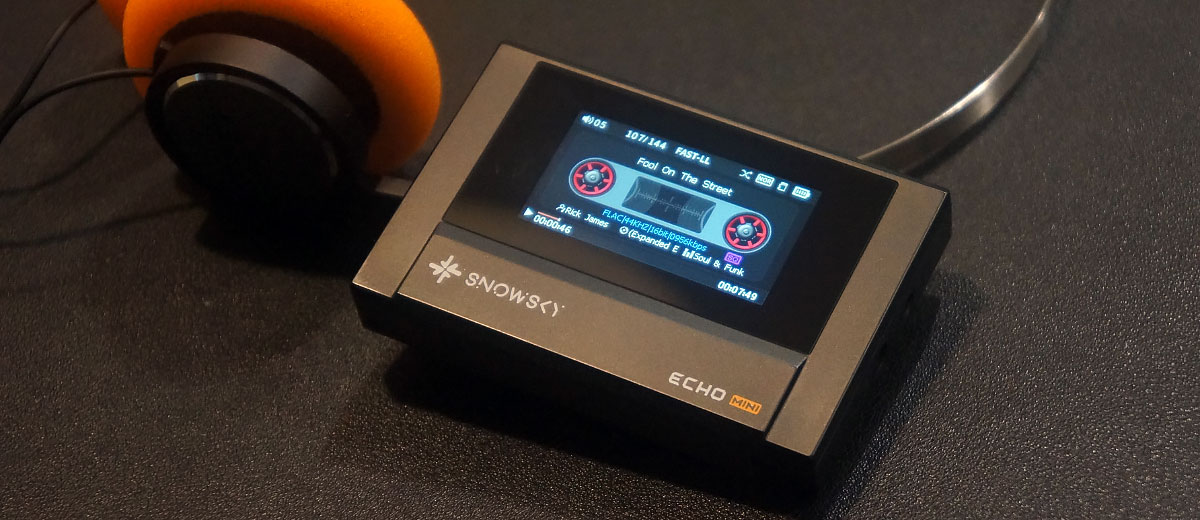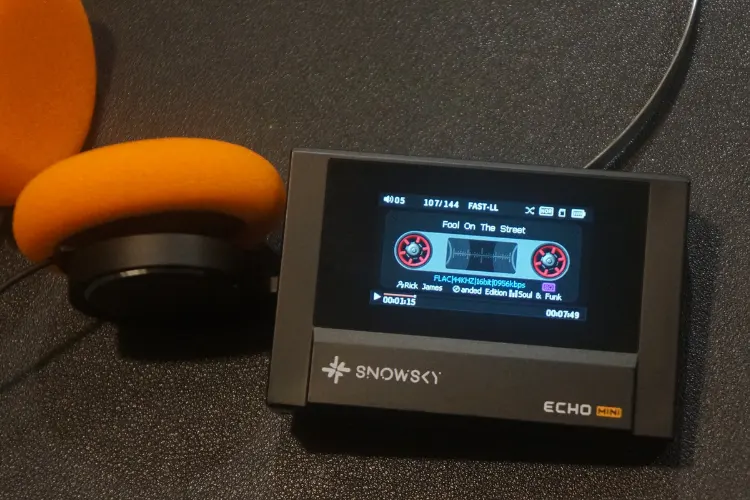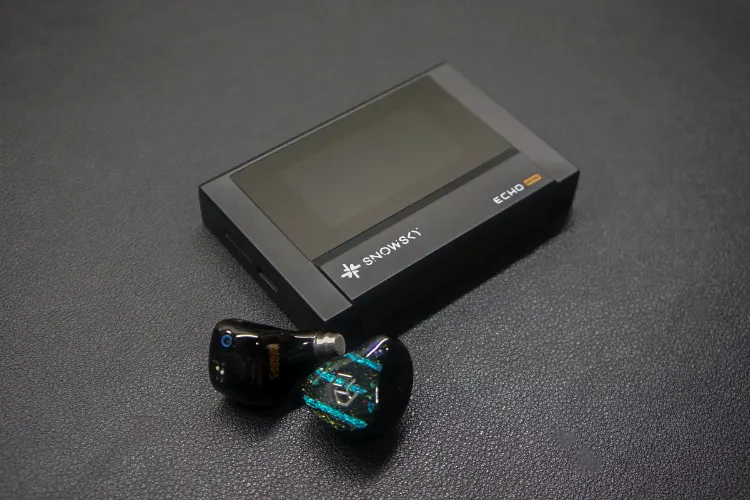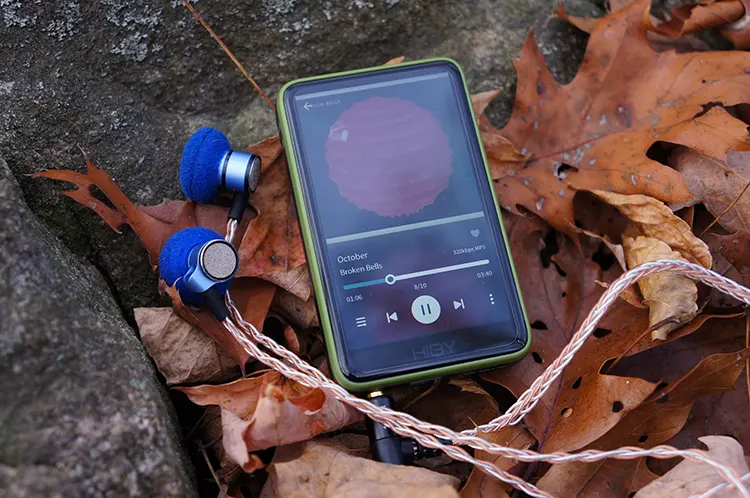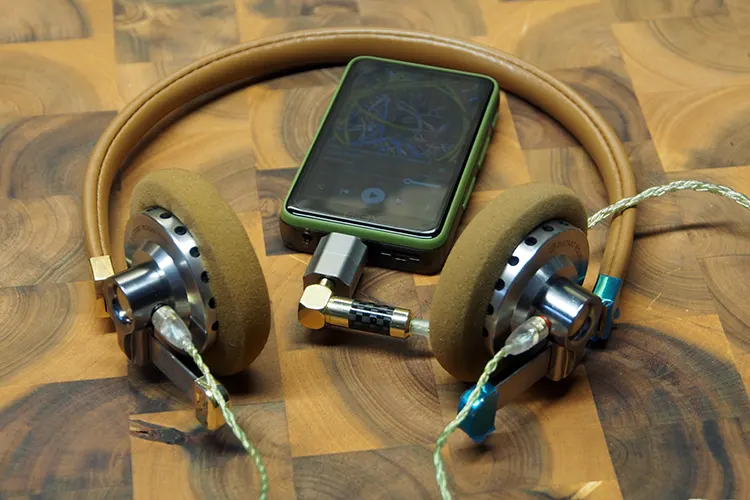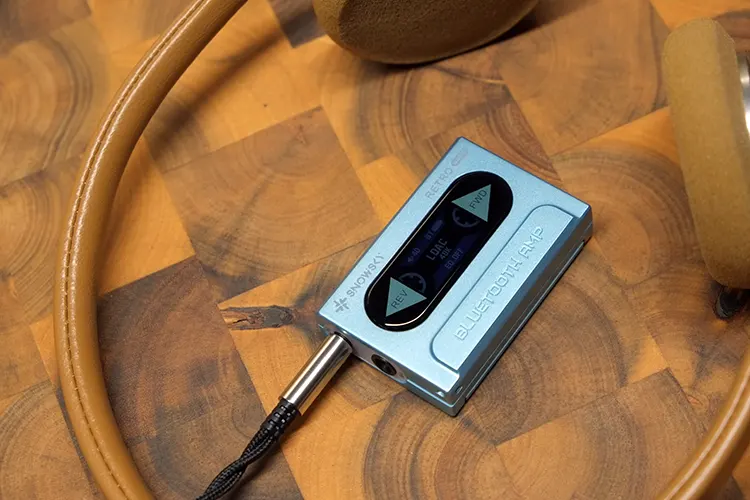Sound Impressions
Summary
Overall, the FiiO SNOWSKY ECHO MINI offers a neutral sound signature with a touch of warmth with controlled bass, clear midrange, and smooth treble, ensuring an enjoyable and engaging listening experience.
While it may not match the resolution and detail retrieval of high-end DAPs, the ECHO MINI provides a pleasing signature that may appeal to many.
Bass
The ECHO MINI delivers a relatively neutral bass response, with a slight emphasis on the mid-bass rather than the sub-bass. While it has a decent low-end presence, it doesn’t reach the deep, rumbling levels found in more bass-heavy sources.
The sub-bass is present but rolls off earlier than expected, making it less impactful on tracks that rely on deep, resonant bass. On the other hand, the mid-bass carries more weight and warmth, providing satisfying body to instruments like bass guitars.
Despite this, bass texture and layering could be more refined, as the ECHO MINI sometimes smooths over finer details in bass-heavy recordings.
Mids
The midrange of the ECHO MINI is arguably its strongest attribute, offering a natural, slightly warm presentation that gives vocals and string instruments a more organic feel.
Male vocals have a solid presence, with sufficient weight and depth to make them sound full-bodied. Female vocals, on the other hand, come through with a slight emphasis, making them airy and expressive without veering into shouty territory.
Instruments such as acoustic guitars and pianos are well-articulated, benefiting from the ECHO MINI’s clean and neutral tuning.
There is also a good balance between instrument separation and midrange cohesion, allowing vocals and background elements to remain distinct without sounding disjointed. This makes the ECHO MINI particularly enjoyable for acoustic-pop tracks.
Treble
The treble on the ECHO MINI is smooth, non-fatiguing, and leans toward a more relaxed presentation. While it doesn’t have the highest level of airiness or sparkle, it avoids harshness and sibilance, making it ideal for extended listening sessions.
This approach means that micro-details in the upper frequencies are somewhat subdued compared to higher-end DAPs, making it less ideal for those who prioritize extreme resolution and treble shimmer.
Staging & Dynamics
The FiiO SNOWSKY ECHO MINI delivers a serviceable soundstage with decent width but limited depth, making it well-suited for intimate genres but less ideal for large-scale recordings.
The imaging is adequate but not razor-sharp, and while instrument separation is generally good, complex tracks may sound a bit congested.
Dynamics lean towards a more relaxed and smooth presentation rather than a highly energetic or punchy sound. While this makes for a fatigue-free and enjoyable listening experience, those looking for a highly dynamic and expansive presentation may find it somewhat lacking.
Synergy
Power
The following tests were done with the Moondrop Blessing 3 and Yanyin Canon II IEMs, while the headphone tests consisted of the Sennheiser HD 580 Precision, SNOWSKY Wind, and the Koss KPH30i.
The ECHO MINI has a 3.5mm single-ended output rated at up to 100mW and a 4.4mm balanced output capable of delivering up to 250 mW, which is quite respectable for a compact DAP.
When testing with IEMs, the ECHO MINI had more than enough power. Using the Moondrop Blessing 3 via the 4.4mm balanced output, I rarely had to push the volume beyond 20 on low gain.
Likewise, with the Yanyin Canon II on the 3.5mm single-ended output, I never needed to exceed 30 on low gain.
Both IEMs were driven effortlessly, without noticeable distortion or loss in detail, proving that the ECHO MINI is more than capable of handling low to moderate impedance IEMs with ease.
Moving to full-sized headphones, however, revealed some limitations in power delivery. While the SNOWSKY Wind and Koss KPH30i were driven without issue, maintaining their natural sound signature and dynamics, the Sennheiser HD 580 Precision presented a challenge.
Even when using the 4.4mm balanced output on high gain, the ECHO MINI couldn’t properly drive the HD 580 with a good low-end extension or dynamic impact.
The bass felt somewhat underpowered, and the overall presentation lacked the sense of authority that a more powerful amplifier would provide.
This suggests that while the ECHO MINI is a solid performer for IEMs and efficient headphones, it may not be the best choice for full-sized, high-impedance headphones.
Pairings
The FiiO SNOWSKY ECHO MINI pairs best with IEMs and headphones that are sufficiently powered by the unit while also benefiting from its added warmth.
Among my tested IEMs, I found the Moondrop Blessing 3 to be the best pairing. I am already a fan of the Blessing 3’s neutral tuning, but I appreciated how the ECHO MINI introduced additional mid-bass body and male vocal emphasis. This made the Blessing 3 a more relaxed listen.
I also enjoyed pairing the ECHO MINI with the Koss KPH30i. While the KPH30i is already a warm-sounding headphone, the ECHO MINI’s slight added warmth did not overly muddy its sound.
Instead, it maintained good clarity and separation, while the ECHO MINI’s power output was more than enough to maximize the headphones’ performance.
I found the pairing with the Yanyin Canon II to be less than ideal. The Canon II already has a V-shaped/U-shaped sound signature with a pronounced mid-bass lift, and the ECHO MINI’s additional warmth further emphasized the mid-bass region, making it less controlled and slightly bloated.
While it was still a decent experience overall, I felt that a more neutral source would be a better fit for the Canon II to maintain its balance and detail retrieval.
Select Comparisons
HiBy R1
Technical
The SNOWSKY ECHO MINI is equipped with dual CS43131 DAC chips, supporting native DSD256 playback and high-resolution 24-bit/192kHz audio. The HiBy R1 features a Cirrus Logic CS43131 DAC, capable of decoding PCM up to 32-bit/384kHz and DSD256.
The ECHO MINI uses 3.5mm single-ended, being able to power up to 100mW at 32Ω, and 4.4mm balanced up to 250 mW at 32Ω. Whereas the HiBy R1 only comes with a 3.5mm SE output with 101mW power output at 32Ω.
With both units coming under 100 USD, they are both running their proprietary operating system.
Design
The ECHO MINI boasts a retro-inspired design reminiscent of vintage cassette players, featuring a 1.99-inch IPS display with animated cassette visuals. Its plastic chassis is available in black, cyan, and pink.
In contrast, the HiBy R1 presents a modern aesthetic with a compact form factor. It also includes a larger 3-inch IPS display that includes touchscreen controls, unlike the ECHO MINI. Despite its predominantly plastic build, it feels solid and well-constructed.
Comparing the two units, the ECHO MINI is slightly smaller; however, the R1 is slightly shorter and narrower. This makes both units equally pocketable and ideal for on-the-go music listening.
Performance
The ECHO MINI has a warmer presentation with thicker and more pronounced mid-bass, making it sound fuller in the low end. In contrast, the HiBy R1 is more vocal-forward with a bit more resolution, especially noticeable in string instruments and vocal textures.
Treble tuning also differs between the two: the ECHO MINI has a more relaxed treble presentation, making it smoother and less fatiguing for long listening sessions.
The HiBy R1, on the other hand, is more engaging and exciting, providing more upper-frequency energy and sparkle.
The ECHO MINI has a wider soundstage than the R1; however, the R1 has better separation and layering in complex tracks.
Ultimately, the ECHO MINI excels in a warm, relaxed, and smooth sound signature, while the HiBy R1 offers a more detailed, engaging, and energetic tuning.
FiiO SNOWSKY RETRO NANO
Technical
The FiiO SNOWSKY ECHO MINI is powered by dual CS43131 DAC chips, supporting native DSD256 playback and high-resolution audio up to 24-bit/192 kHz. It offers 3.5mm single-ended (100mW @ 32Ω) and 4.4mm balanced (250 mW @ 32Ω).
The RETRO NANO sports the same DAC chips; however, it tops out at PCM 96 kHz and has a lower power output of 100 mW via its 3.5mm SE output and 220 mW via its 4.4mm balanced output.
The ECHO MINI includes a 1.99-inch IPS display and operates on an RTOS platform, while the RETRO NANO features a 0.96-inch color IPS screen.
It is important to point out that while the ECHO MINI is a DAP, the RETRO NANO is merely a wireless DAC/AMP; therefore, all comparisons between the two units will be done with the RETRO NANO paired to my iPhone 14.
Design
Both devices embrace a nostalgic design reminiscent of vintage cassette players. The ECHO MINI measures approximately 80 x 54.5 x 14.5 mm and weighs about 55g, featuring a plastic chassis available in black, cyan, and pink.
It includes tactile buttons for power, volume, playback, and menu navigation, and a lanyard strap for portability.
The RETRO NANO is more compact, measuring 55.1 x 37.5 x 13.7 mm and weighing 28.3g. It also sports a plastic build with a retro aesthetic and includes a 0.96-inch color IPS screen that displays cassette-like animations during playback.
The device features physical buttons for control and a removable battery compartment, enhancing its practicality.
Performance
Both the SNOWSKY ECHO MINI and SNOWSKY RETRO NANO share a similar sound signature due to their dual CS43131 DAC implementation. However, subtle differences in their tuning create distinct listening experiences.
The ECHO MINI has a warmer presentation with a thicker and more pronounced mid-bass. This difference is especially noticeable in funk and disco tracks, where basslines have extra weight, giving the music a fuller and more dynamic presence.
The RETRO NANO maintains warmth but has a slightly leaner bass response, making it sound a bit more neutral in comparison.
Male vocals are more emphasized and full-bodied on the ECHO MINI, lending a richer and more natural tone to deeper voices, while the RETRO NANO presents vocals in a more balanced and neutral manner.
Treble presentation differs slightly between the two. The ECHO MINI has a more relaxed treble, smoothing out harshness in high frequencies while maintaining detail.
The RETRO NANO is a touch more energetic, offering a slightly more forward and analytical presentation without being overly sharp.
My Verdict
FiiO has introduced their SNOWSKY sub-brand with quite a splash. Priced just under $50, the FiiO SNOWSKY ECHO MINI is surprisingly feature-rich for a dedicated DAP with a high enough power output to drive almost all IEMs and some less demanding headphones.
It is by no means perfect; I would have appreciated having a USB DAC mode so I could leverage its power output while connected to my computer. Its control scheme has some quirks as well.
But with its wallet-friendly price and admittedly charming retro aesthetics, the ECHO MINI is worth a listen for anyone looking to step back into the world of dedicated music players.
FiiO SNOWSKY ECHO MINI Technical Specifications
- Dimensions: 80 × 54.5 × 14.5 mm
- Display: 1.99-inch IPS color LCD
- Internal Memory: 8 GB
- External Memory: Expandable via microSD card up to 256 GB.
- DAC: Dual Cirrus Logic CS43131 DAC chips
- Formats: DSD, WAV, FLAC, APE, MP3, M4A, OGG
- Power: 100 mW (3.5mm), 250 mW (4.4mm)
- Battery Capacity: 1,100 mAh

